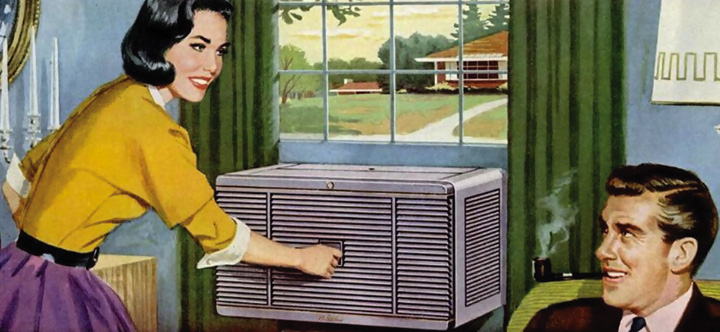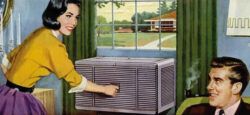Magazine
Suddenly Less Summer
How air conditioning transformed the South
Published: September 2, 2015
Last Updated: May 3, 2019

We are reminded, but also removed from the sounds, smells, prickly heat and itch of bug bites that defined summer in the South before the invention of air conditioning. And with no automobile traffic to distract from the sound quality, the Madisonville branch is blissfully hushed.
The library was the site of “Suddenly Less Summer,” a four-week reading-and-discussion program this past spring organized by Adult Programs Director Mimi Nothaker and scholar Milly Vappie, and funded by the Louisiana Endowment for the Humanities. Today I arrive to lead a final session to record oral histories with participants on the impact of A-C on their lives. The library’s Benny Bruce has already set up microphones and cameras as the storytellers begin to arrive.
The first week of the program began with a keynote address from Dr. Ray Arcenault on the history of air conditioning, beginning with Willis Carrier, inventor of the first air conditioner in 1902. The window units that followed in homes of the late 1950s and ‘60s promised “quiet cool” while they rattled against the screws of the insert kit and hummed loud enough to drown out all competing noises. By the 1970s, the compressors of central-air units moved the cacophony outside.
None of today’s participants wants a return to the sweltering days of the past, but some of the romance of summers gone by seems lost. Fourteen participants who agreed to share their stories of that time reveal a lifestyle that is foreign to their grandchildren and even to some of their children. They describe hours of freedom to play outside unattended by adults, and the long, comforting evenings on front porches with friends and family. They recall the sounds of nature, of mothers calling children home from play, of church bells and mill whistles. Folks found a myriad of methods for cooling off, ranging from soaking their feet in buckets of ice water to swimming in the artesian pool of Abita Springs.
During an afternoon at the library, North Shore residents reminisced about fanning themselves in church pews and playing outside as long after sunset; the arrival of window units and central air in homes and public buildings; and the shock of the oppressive heat of late August 2005 when Hurricane Katrina forced them to do without air conditioning. What follows are their memories and photos, reminders of the impact of technology on our experience—and comfort—during the summer months.
The Yard, Front Porch, Fishing Camp and Church
Despite the ingenious design of raised houses with long center halls, high ceilings, open windows in every room and a covered porch, all the storytellers recalled hours of playing outside because their homes were hotter than their yards. Whether in the country or living in town, the children played under shade trees and in water wherever they could find it. In the 1950s New Orleans’ air-conditioned drugstores, soda fountains and commercial sno-ball stands provided temporary relief, but these arrived a bit later on the North Shore. Children in small St. Tammany towns roamed for blocks unsupervised, but sound carried so well that adults could probably hear them.
“The wind was a defining factor,” says Rose Anne Bivens. The neighbors were united by an “unplugged sound system.” In Covington everyone heard the church bells of St. Peter’s Catholic Church, the hand-held bells at the grammar school and bells on children’s bikes. The whole town heard the noon whistle at Mackie’s Mill and went home for lunch. Sheila Delacroix recalls fondly the sound of mothers “singing the children home” from evening play, her own crying out, “Shee—la!” Bivens recalled she could smell what her neighbors were having for supper before she arrived at her doorstep: “Fried chicken, meatloaf, boiled crabs or cabbage.”
Ida Thomas James spent the hours between supper cleanup and bedtime down the block in her grandmother Mameaux’s yard, a child’s Garden of Eden. She describes it as a “snack bar” where the season’s fruit usually hung from the trees. Eva Baham recalled evenings when neighborhood families met outside. The women sat on the porches and fanned themselves, the men clustered on the corner to talk, and the children played in the yards. Children were not to intrude on the adult conversations, but were free to entertain themselves with hide-and-seek and platting clover chains. As darkness settled, the adults brought out the smoke pot to keep off mosquitoes, and the children were given teacake treats.
Sometimes the children ventured out of the neighborhood. In Covington, grammar school children were allowed to hike several blocks to Boguefalya Park to swim at the beach. Morgan’s Pool, an artesian pond on the outskirts of Abita Springs, charged children a nickel to swim.
In Old Mandeville even young children went unattended to the Lake Theater that faced Lake Pontchartrain. The owners would open the doors and turn on two huge fans—one on each side of the screen. Bernadette Galatas recalls the young audience, bored with the movie, would throw their popcorn and candy wrappers over the protective screening, and the whirring blades would spew out refuse to universal delight. As the children walked home, voices would call out from the darkened house porches asking if they liked the movie or how their relatives were doing.
Families sometimes looked beyond the North Shore towns for relief from the heat. Fishing camps hovered on stilts out in the Rigolets, at Lake Catherine or Lake Pontchartrain. Suzanne King, a longtime Covington resident, described visiting her Uncle Henry’s camp at Lake Catherine. At night, after the children bedded down on the screened porch, Uncle Henry would come out and announce, “OK kids, hold your breath.” He would pump a puff of Gulf insecticide over each sheet-covered head. A soft mist settled on fingers holding the sheets. That would keep the mosquitoes at bay, at least until all the children were asleep.
Churches in the Deep South defined community before air conditioning and continue to do so today in the small towns on the North Shore. Methods of dealing with the heat have changed. “The fan” in local African American churches did not refer to an electrical appliance but to a handheld device used only by women and girls. Men wore their best suits and suffered silently. Eva Baham and Lily Butler described how women wore fancy dresses, cotton or nylon stockings, heels, hats and gloves. Their one concession to the oppressive heat during the 3 o’clock special program was to fan themselves. Local funeral homes or insurance companies provided cardboard fans that were stacked at the end of each pew. The most fashionable girls produced carefully guarded plastic oriental fans.
The local Catholic Church affixed oscillating fans to the columns running down the nave. A wise parishioner got to Sunday Mass early to position herself back an aisle or two where the breeze was most pronounced.
The Transition: The Attic Fan and the Window Unit
Behind the open screen doors and windows, some lucky folks switched on the attic fan. The noise of the louvers breaking the vacuum and the large blades starting up sounded like a “747 taking off” according to Sheila Delcroix. Air would rush into the house. Box fans and oscillating fans became commonplace, but the days and nights were still hot.
George White remembers only a few stores in Madisonville that boasted the sign “It’s Cool Inside.” Most stores still had fans and a screen door with ads for Merita Bread, Sunbeam or Holsum painted on the center metal bar. Schools on the North Shore, like homes, were air-conditioned piecemeal. As climate control gradually became the norm, and the principal’s office might be the only air-conditioned room in the school building.
At home, parents started with their own bedroom. My parents guarded their A-C: “Don’t let the air out!” my mother would cry if I dared to open the bedroom door. Peggy Usner’s parents were more generous. After they installed a Mathis window unit in the master bedroom of their home in New Orleans’ Gentilly neighborhood, her father felt sorry for his daughters suffering through the hot nights across the hall. He created a duct by taping cleaner bags together and attaching the “hose” to one of the unit’s two A-C vents. He ran the hose up the bedroom wall across the ceiling and hallway to their room.
Jim Long recalls his first encounter with his grandparents’ bedroom A-C as a “religious experience.” He would climb up on his grandparents’ bed to gain enough height to stand in front of the vents. The room was dark except for flickering vigil lights in front of his grandmother’s altar, a miniature replica of the one in St. Louis Cathedral.
Central Heat and Air: A Brave New World
Air conditioning evolved from its status as a creature comfort to a right—or at least as a perceived necessity. Air conditioning, the GI Bill and the television set combined to produce tract houses and high-rise apartment buildings in post-World War II America. Not only did we move inside to work, eat and live, we traveled in air conditioned cars between these spaces. Arcenault catalogs the rise of residential A-C from 1951 to 1955 when one in ten homes had some form of air conditioning. By the mid 1960s more than 40 percent of new homes in the region were equipped with central air.
Perhaps the best gauge of how essential A-C is to our lives are the stories told about its temporary disruption following Hurricane Katrina in 2005.
Kate Deshommes weathered the storm in Abita Springs where trees were downed all over her yard. Her house was still habitable, so she coped for a week by wearing a thin cotton nightgown all day and keeping a bathtub full of cold water to soak in. Eva Baham and her husband had remained in their Slidell house during the storm, but the heat in the aftermath became unbearable. The September highs peaked at 97 degrees; the mean temperatures for the month hovered in the 80s. “It was not only hot but the nights were still,” says Baham. “All the animals were gone. There were no birds. Nothing.” They left for Baton Rouge to stay with friends who had central air. “We loved it.”
The storytelling ends for the day, but the participants hang around to share and compare. Even without a porch, mosquitoes and the aroma of supper through open windows, these people have created a real sense of community.
—–
Susan Blalock, Ph.D., professor emerita at the University of Alaska Fairbanks, lives in Abita Springs. She has facilitated several programs for Louisiana Endowment for the Humanities through the St. Tammany Parish Library Adult Programs.
